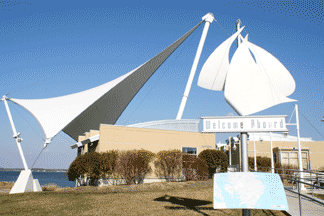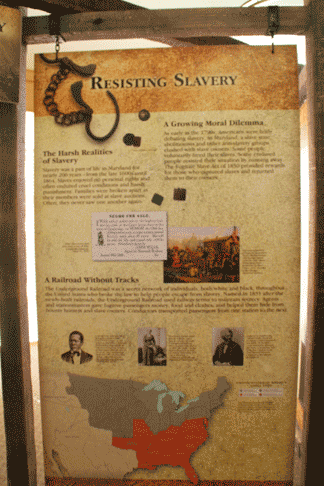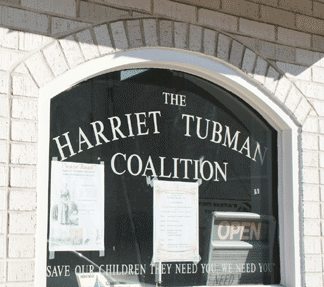|
|||||||||
|
|||||||||
|
|||||||||
Seeking Black History across the BayOn the trails of Frederick Douglass and Harriet Tubmanby Ben and Cathy MillerThe Eastern Shore is a land of farms and waterways where
black people have lived and worked for centuries. In February — African American Heritage Month — we drove east across the Bay Bridge to see what we would find. Could we trace their history? Or would we find little that marked these people’s lives and contributions? We found plenty. We learned about Frederick Douglass, colored schools, Harriet Tubman and the Underground Railroad. We learned that Marylanders honor their African American heritage. Setting out on the Douglass TrailOur planned destination, as we crossed the Bay Bridge on Route 50 East, was Cambridge, where we hoped to visit the mid-Shore’s only museum dedicated to black history. But the Harriet Tubman Museum was closed that Saturday morning. Cathy left a phone message, and we stopped short at Easton. At the Talbot County Visitor Center, on 11 South Harrison Street near the Tidewater Inn, we found what we were looking for: A Frederick Douglass driving tour of Talbot County, where Douglass was born on a farm in 1818. This self-taught genius escaped slavery a few months before his 21st birthday to become an intellectual giant of the 19th century: a writer, editor, abolitionist and crusader for justice for his people. Before we began the two-hour driving tour of 14 sites important to Douglass’s life, we walked around Easton. There is much to see in this town of 14,000: antique shops, galleries, a well-stocked bookstore, good restaurants and the well-regarded Academy Art Museum. The pace slowed as shops and conversation with proprietors diverted the extrovert of the two of us. We learned from more than one person that Easton is a great place to live and that some Easton residents regard Annapolis as a harried urban nightmare of traffic and congestion. Back on track, we visited the Historical Society of Talbot County. From the exhibit Slates to Laptops: Education on the Eastern Shore, 1670 to 2005, we learned that the first “colored school” was established in 1873 in the village of Trappe. Often, black students learned from old textbooks passed down after the white students had finished with them. Not until 1966 did all Talbot County schools desegregate. A Change of PlansDuring lunch, Cathy’s cell phone rang. The now-open Harriet Tubman Museum was calling us. The Frederick Douglass driving tour would wait for another day. Cambridge is 17 miles south of Easton on Route 50 East. From the bridge over the Choptank River, we saw on our right the Dorchester County Visitor Center at Sailwinds Park with its distinctive sculptural sail. This meant another stop. For day-trippers there is no such thing as too much information. Sailwinds Park has spectacular views of the Choptank. The mile-long walk along the river tempted us, but time and strong winds deterred us. Inside, we found interesting displays and, to our delight, an exhibit on the Underground Railroad.
The Underground Railroad was neither underground nor a railroad. Free blacks, whites (including many Quakers) and enslaved blacks organized this clandestine network of routes and safe houses to help African Americans escape from slavery to freedom. Stops, we were to learn, were 12 to 15 miles apart, the distance that could be covered walking in a night. People fled on Saturday night, knowing that sheriffs and other lawmen would honor the Sabbath and not begin searching until Monday morning. All these people, including those escaping slavery, risked their lives and defied the laws of the United States. This exhibit introduced us to our last stop: the Harriet Tubman Museum. Tubman, the most famous conductor on the Underground Railroad, was born a few miles from Cambridge in 1820. The museum was a treat, not because of expensive exhibits, but because it shows the conscientious efforts of its supporters. A concise documentary film tells the story of Harriet Tubman. She was, like Douglass, born enslaved, and, also like him, had remarkable character. Tubman was 29 when she escaped to freedom in the North. She never learned to read, but became famous in her time through her strength of will and service to others. Free herself, she returned to Maryland as many as 19 times to rescue an estimated 70 people from slavery, including her parents and many friends and family members. We were lucky in our visit, as the very knowledgeable Donald Pinder was staffing the museum. Pinder, head of the Harriet Tubman Organization, which runs the museum, told us much of what we learned about Harriet Tubman and her life in Dorchester County. At afternoon’s end, we returned across the Bay Bridge, planning to return another day for a second chapter of African American history on Maryland’s Eastern Shore. Talbot County Office of Tourism: 11 South Harrison St., Easton; 9am-5pm M-F; 9am-noon Sa; Closed Su.: 410-770-8000; www.tourtalbot.org.Historical Society of Talbot County: 25 S. Washington St., Easton; 10am-4 pm M-Sa, Closed Su; 410-822-0773, www.hstc.org.Visitor Center at Sailwinds Park: 2 Rose Hill Place, Cambridge; 8:30am-5pm daily; 410-228-1000; www.tourdorchester.org.Harriet Tubman Museum and Educational Center: 424 Race St., Cambridge; 10am-3 pm Tu-F; noon-4pm Sa: 410-228-0401. |
|||||||||
|
|||||||||
|
|
|||||||||
|
© COPYRIGHT 2008 by New Bay Enterprises, Inc. All rights reserved. |
|||||||||



